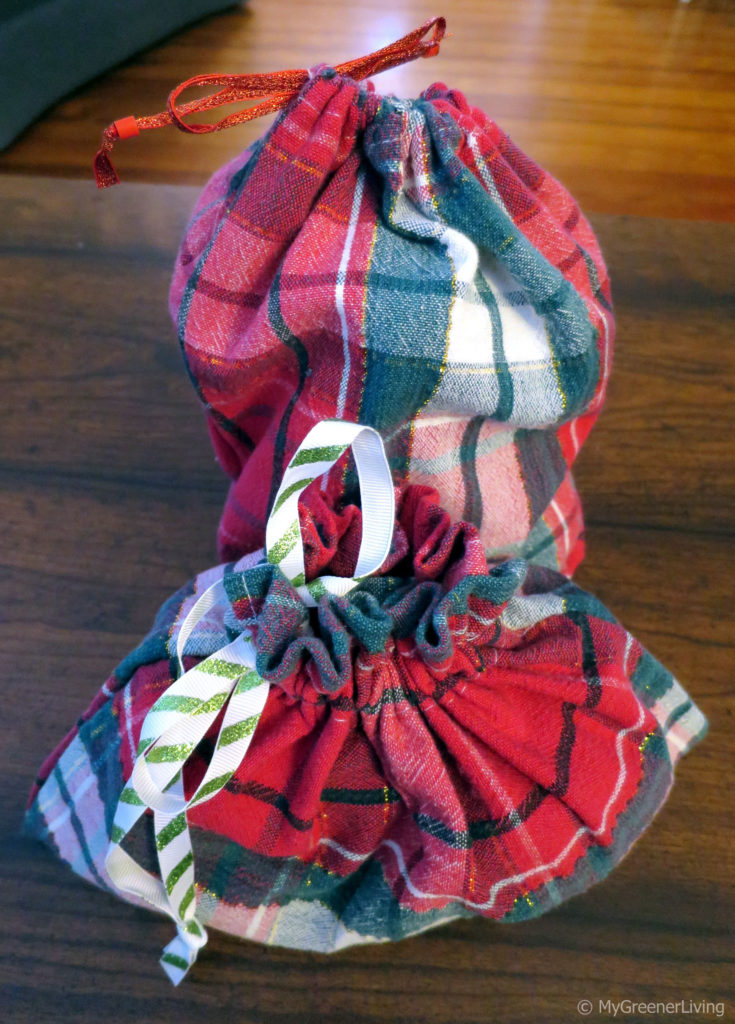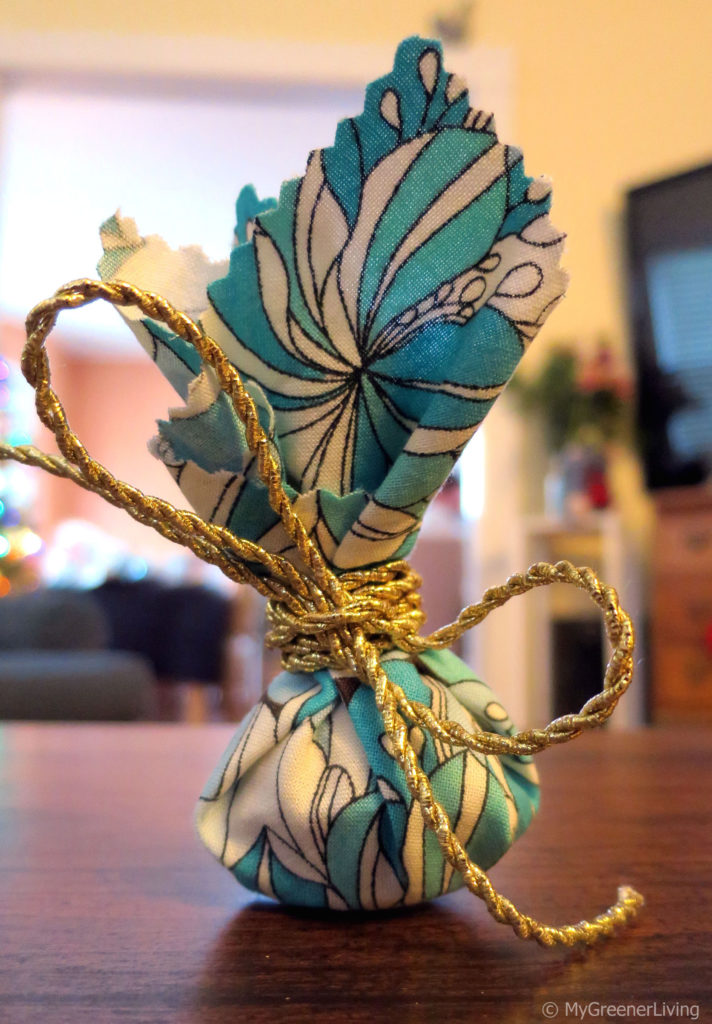Growing up, my family always reused gift bags until they looked too worn or fell apart. I think it was part frugal, and part “why throw away something perfectly good and useful?” I have carried that into my adult life, and tend to avoid wrapping paper due to the single-use aspect. A couple years ago, I decided to up my game and make longer-lasting reusable gift packaging.

Disclaimer: This post contains affiliate links. See my Disclosure Policy for more information.
Reusable Gifts Bags
I decided to tackle Christmas wrapping first. I found a large Christmas tablecloth at a thrift store (Savers – my favorite thrift store in my area) for $5. I picked up some ribbon on clearance from Michael’s and Christmastree Shops. I was ready to go!
Sewing designs for reusable gift bags

I first used a draw-string backpack for inspiration on how to design my gift bag. After making a couple, I realized I would improve my design by using used a draw-string jewelry bag for inspiration, instead. The difference is that the backpack has just one pocket running around the top of the opening, through which the string or ribbon is run. The jewelry bags have two pockets, one over the other, with the ribbon running through the bottom one. This allows the top “pocket” to fold and ruffle and look more pretty and gift-y!

Simple designs
I’ve made some very simple reusable gift bags that were just a rectangle of fabric, folded in half and sewed, leaving one side open. Rather than having an integrated draw-string, I’ve just tied a ribbon around the top. This shape bag works well for more fat, envelope-shaped gifts, but doesn’t work as well for thicker rectangular or round gifts.

Cylindrical fabric reusable gift bag
My favorite style reusable gift bag has a more cylinder shape. I have found this to be most versatile, since it can incorporate a wide range of gift shapes. Even rectangular boxes fit well. To make these, I cut out a circle of fabric (I trace a bowl or plate, I couldn’t draw a circle to save my life! But really, the shape doesn’t matter. Ovals work fine.) I then cut a rectangle of fabric with one length the same as the circumference of the circle.

What About No-Sew Designs?
I have sewed all of my reusable gift bags, because I’ve been sewing since I was a kid and I find basic sewing to be easy enough. The no-sew alternative that I thought of was fabric gluing instead of sewing. Theoretically any design could be made this way, and as long as the glue was allowed to dry thoroughly, it should hold up pretty well.
I personally would try to flat/rectangle designs first, as they do not require holding up more complex shapes. It’s just folding fabric, gluing, and letting dry.
There’s also an even simpler reusable gift bag option that uses no sewing, no glue, just fabric and ribbon or string to tie. Just cut out a somewhat square or circle-type shape (pinking shears are advisable as they will prevent fraying, but are not essential). Place the gift in the middle, gather up the fabric, and tie the fabric above the gift. Just like wrapping a gift basket!

For a more smooth, finished look more similar to using paper to wrap gifts, the Japanese furoshiki cloth wrapping style looks great! I have not spent much time playing around with this wrapping style, so I will point you over to this Wellness Mama post for some great instructions.
Cost to Make Fabric Reusable Gift Bags
My large tablecloth provided enough fabric for me to make about 10 reusable gift bags of varying sizes. Considering the best prices I have found for paper gift bags is $0.50-$1.00, I think I did pretty well for myself! I did put in more time than purchasing gift bags, but I enjoyed it, and I enjoy knowing that these will last for years and are keeping waste out of landfills.
Reusable Gift Tags
I also decided to make some reusable gift tags. I was inspired by these little flat wood pieces with festive designs on one side. I found them on clearance at Michael’s for $0.10 right after Christmas a couple years ago.

I drilled a small hole in the top for a string to use for attaching to gifts. Then I mixed up some chalk paint using black acrylic paint and some dry spackle in a ratio of about 10 parts paint to 1 part spackle and painted it on the back of the wood pieces. I painted 3 layers, allowing to fully dry between coats. Then I tied a little cotton string through the hole. I use chalk to label the tags, then use the drawstring bag ribbons to attach the tag to the gift wrap.
Note: I used spackle that I have had for ages, and I cannot find that type anymore. From my research, it seems unsanded grout also works pretty much the same. Also, both acrylic and latex paints work.

This year, I have been able to wrap all of my gifts in these reusable gift bags or other gift boxes or reusable bags that I have acquired over the years. I plan to make more bags in different fabrics, and more tags, to make sure I always have enough! I found another $5 tablecloth at Savers and am just waiting until I have some time to transform that fabric into more reusable gift bags.





